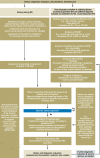Local treatment of chronic wounds: in patients with peripheral vascular disease, chronic venous insufficiency, and diabetes
- PMID: 23413377
- PMCID: PMC3566621
- DOI: 10.3238/arztebl.2013.0025
Local treatment of chronic wounds: in patients with peripheral vascular disease, chronic venous insufficiency, and diabetes
Abstract
Background: A chronic wound is defined as an area where the skin is not intact that fails to heal within eight weeks. Such wounds usually develop on the lower limbs as a complication of diabetes, venous insufficiency, or inadequate arterial perfusion. Most of the roughly 45,000 limb amputations performed in Germany each year are necessitated by non-healing chronic wounds.
Methods: In the development of this S3 guideline, a systematic search was performed that yielded 4998 references including 38 randomized, controlled trials and 26 systematic reviews, which were used as the basis for the recommendations and statements made in the guideline. Twelve member societies of the umbrella Association of Scientific Medical Societies in Germany (Arbeitsgemeinschaft der Wissenschaftlichen Medizinischen Fachgesellschaften, AWMF), as well as the German Association of Nursing Science (Deutsche Gesellschaft für Pflegewissenschaft, and patient representatives participated in the consensus rounds in which the guideline's recommendations and statements were agreed upon.
Results: This guideline contains seven evidence-based recommendations and 30 good clinical practice (GCP) recommendations. Evidence-based recommendations are given in favor of hydrogel, hyperbaric oxygenation, and integrated care, and against the use of medicinal honey and growth factors. Terms are defined precisely in order to ease communication and to specify what is meant by "wound debridement" (a procedure performed by a physician) as opposed to cleansing a wound. Under the premise of preventing pain, exudation, and maceration, local therapeutic agents can be chosen on the basis of the scientific evidence, the patient's preference, the physician's experience, and the wound situation. Costs should also be considered.
Conclusion: Scant evidence is available to answer many of the relevant questions about chronic wounds. There are valid data in support of hyperbaric oxygen and integrated care. More research is needed.
Figures






Comment in
-
Benefits of hyperbaric oxygen therapy still doubtful.Dtsch Arztebl Int. 2013 May;110(21):372. doi: 10.3238/arztebl.2013.0372a. Dtsch Arztebl Int. 2013. PMID: 23795212 Free PMC article. No abstract available.
-
Hydrogel dressings are obsolete.Dtsch Arztebl Int. 2013 May;110(21):372-3. doi: 10.3238/arztebl.2013.0372b. Dtsch Arztebl Int. 2013. PMID: 23795213 Free PMC article. No abstract available.
-
Topical honey for diabetic foot ulcers.Dtsch Arztebl Int. 2013 May;110(21):373. doi: 10.3238/arztebl.2013.0373a. Dtsch Arztebl Int. 2013. PMID: 23795214 Free PMC article. No abstract available.
-
Wound care products are not completely expendable.Dtsch Arztebl Int. 2013 May;110(21):373-4. doi: 10.3238/arztebl.2013.0373b. Dtsch Arztebl Int. 2013. PMID: 23795215 Free PMC article. No abstract available.
-
Clear decision criteria are lacking.Dtsch Arztebl Int. 2013 May;110(21):374. doi: 10.3238/arztebl.2013.0374a. Dtsch Arztebl Int. 2013. PMID: 23795216 Free PMC article. No abstract available.
-
In reply.Dtsch Arztebl Int. 2013 May;110(21):374-5. doi: 10.3238/arztebl.2013.0374b. Dtsch Arztebl Int. 2013. PMID: 23795217 Free PMC article. No abstract available.
References
-
- Persoon A, Heinen MM, van der Vleuten CJ, de Rooij MJ, van de Kerkhof PC, van AT Leg ulcers: a review of their impact on daily life. JClinNurs. 2004;13:341–354. - PubMed
-
- Deutsches Netzwerk für Qualitätsentwicklung in der Pflege (DNQP) Osnabrück. 2008. Expertenstandard zur Pflege von Menschen mit chronischen Wunden.
-
- Gonzalez-Consuegra RV, Verdu J. Quality of life in people with venous leg ulcers: an integrative review. J Adv Nurs. 2011;67:926–944. - PubMed
MeSH terms
LinkOut - more resources
Full Text Sources
Other Literature Sources
Medical

